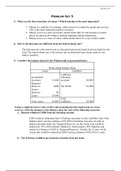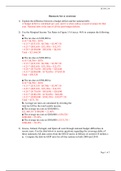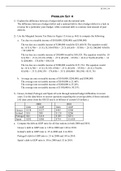Econ 214 problem set 5 Study guides, Class notes & Summaries
Looking for the best study guides, study notes and summaries about Econ 214 problem set 5? On this page you'll find 3 study documents about Econ 214 problem set 5.
All 3 results
Sort by

-
ECON 214 Problem Set 5
- Exam (elaborations) • 2 pages • 2020
-
- $12.49
- + learn more
1) What are the three functions of money? Which function is the defining characteristic? 2) How is the discount rate different from the federal funds rate? 3) Consider the balance sheet for the Wahoo bank as presented below. Wahoo Bank Balance Sheet Assets Liabilities government securities $1,600 Liabilities: Checking accounts $4,000 Required Reserves $400 Net Worth $1,000 Excess Reserves $0 Loans $3,000 Total Assets $5,000 Total Liabilities $...

-
ECON 214 Module 5 Problem Set 4 Answers
- Exam (elaborations) • 3 pages • 2020
-
- $12.49
- + learn more
1) Explain the difference between a budget deficit and the national debt. 1) Use the Marginal Income Tax Rates in Figure 15.6 (see p. 463) to compute the following: a. ■ The tax due on $100,000 is: ■ The tax due on $200,000 is: ■ The tax due on $500,000 is: b.Average tax rates are calculated by dividing the total tax bill by the total taxable income. ■ The average tax rate on $100,000 is ■ The average tax rate on $200,000 ■ The average tax rate on $500,000 2) Greece, Ireland, Port...

-
ECON 214 Problem_Set_4
- Exam (elaborations) • 2 pages • 2020
-
- $12.49
- + learn more
1) Explain the difference between a budget deficit and the national debt. 2) Use the Marginal Income Tax Rates in Figure 15.6 (see p. 463) to compute the following: 3) Greece, Ireland, Portugal, and Spain all went through national budget difficulties in recent years. Use the data below to answer questions regarding the sovereign debts of these nationals (All data comes from the OECD and is in billions of current US dollars.). 4) Explain the differences between typical demand side fiscal polic...

$6.50 for your textbook summary multiplied by 100 fellow students... Do the math: that's a lot of money! Don't be a thief of your own wallet and start uploading yours now. Discover all about earning on Stuvia


